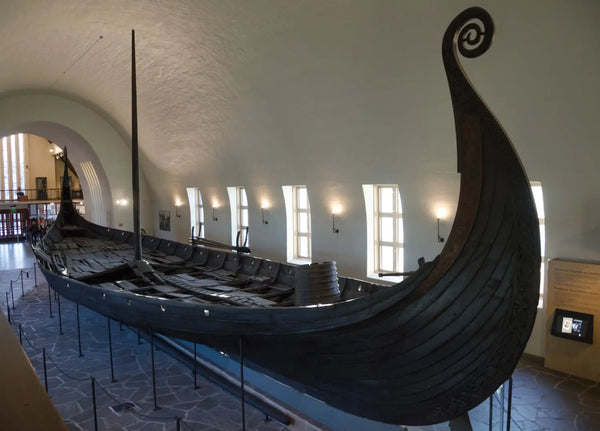Drakkar: The Longship of the Vikings
The Vikings’ longships did follow the guidelines of general shipbuilding shape of being long and narrow. Their general term was langskip (longship) and were opposed to the wider merchant ships called Knarr or Kaupskip, often maintaining a 7:1 length/wide ratio.
Merchant ships were shorter in length, but wider than warships. Their main part was deeper and heavier in order to increase their capacity for commercial products. They had few oars, which were used for maneuvering near the shores. For their movement they relied on sails and their masts were permanently placed on the ship (whilst they could be removed in warships).
The well-known term Drekar or Drakkar does not correspond to a separate class of ship. It simply describes the largest of the Viking fleet's warships, which bore the shape of a dragon, indicating that they belonged to a king or nobleman, while their construction would cost a bundle. Their bow had also the sculpted tail of other animals. In addition to the dragon, the snake, the eagle, the ram and the hawk were common in Viking ships.
The main weapons of the Vikings were not axe or swords, but their very flexible and durable warships, the Drakkars. Their value was particularly great, both economically and socially. With their ships, the Vikings performed both successful trading routes and successful raids.
These activities are not as distinct as one would expect. In their trade voyages in 7th and 8th centuries the Scandinavians had the opportunity to get acquainted with their future rivals. Utilizing their naval experience, they memorized and drew the map of the coastlines, the sea currents and the directions of the wind. At the same time, they located the main trading posts and rich ports and explored the river routes that led to rich hinterlands. Thanks to these contacts, they appreciated the political and military power of their opponents.

Material and Sail Construction
The basic material for making sails was wool. The woolen cloth could isolate the cold and absorb large amounts of moisture without getting wet. For this reason, the rest of the navy accessories, clothes, gloves, etc. were also made of wool, a custom that is followed faithfully to this day.
Large quantities of wool were collected to make the sail. In general, a warship including 65-70 men could require more than 1.5 tons of wool for sailing and complete equipment. Assuming the fleet used by the Danes and Norwegians in the Viking Age, almost one million square feet of sail would be required.
The square sail was not a single piece but consisted of several pieces of woolen fabric which were sewn together. At this phase the fabric was fluffy, rough and exposed to the sprays of the sea or the rain, it got wet and started dripping.
In the next phase, the already sewn fabric, is spread with fats such as animal fat, fish oil, etc. mixed with ocher to reduce air permeability and to make it waterproof. At the same time, via this lubrication, the smoothing of the irregularities of the fabric was achieved as well as differences in its surface (protrusions, hardenings, etc.) between the separate sewn parts.
Few data are available on the lifespan of Viking sails. However, experts believe that, with careful treatment, they could last 40-50 years. Aged sails, which could no longer be used on ships, were used as bedsheets or rugs.
Most sails used to be red was believed to create awe to the enemy. Bright colors, such as blue, both on the entire surface of the sail and in stripes, are praised in poems of that time, such as that of Sigvat Skald, which states that King Knut sails on a ship with a blue sail. Finally, fiber, seahorse, whale or seal skin, and horsehair were used to make the ropes.

Ship Construction and War
The construction technique of Drakkar was common, that is overlapping boards were fastened together with simple joints. The boats also had duplicate, identical ends at the bow and stern. This structural peculiarity allowed Viking ships to sail with ease, especially in rivers and with minimal changes of course. Another feature was the one-side rudder, always on the right side of the ship, as well as a mast with a square sail. The types of Scandinavian ships (and also Drakkars) were shaped following the evolution of a long shipbuilding tradition.
When preparing for a naval battle or approaching shores, Vikings often lowered the sails to facilitate operations or to hide their intentions.
The most recent Drakkar we know that was built is the Ship of Christ (Kristsuden), which was built in 1262 - 1263 in Bergen, Norway for King Haakon IV. The ship had 74 rowers and was probably the largest in its class.
Viking ships were insurmountable in terms of range and raid ships, but eventually degraded and lost their combat value due to their only possible disadvantages: their very low deck due to which they had a low draft, and their fragile construction. They could not face the modern Mediterranean ships that had a higher or much higher deck since they were galleys that had two or three rows of oars (dromons, biremes, triremes and other warships of the Byzantines, Arabs, Venetians, Genoese, Catalans etc.).
For this reason, the Vikings had few successful raids in the Mediterranean. It is noteworthy that the Normans of Italy, cultural descendants of the Vikings, did not use Scandinavian Drakkars, but Mediterranean-type warships. It was impossible for the Vikings to climb over the deck of their own ships to that of the Mediterranean where they would begin their usual infantry deck battle (the Vikings' basic tactic in naval battle) because they received shower of arrows and missiles from foe’s high deck. In addition, much heavier Mediterranean vessels could easily sink Scandinavian ships by ramming them and tearing them in half.
Written By Stefan
Northlord Team
